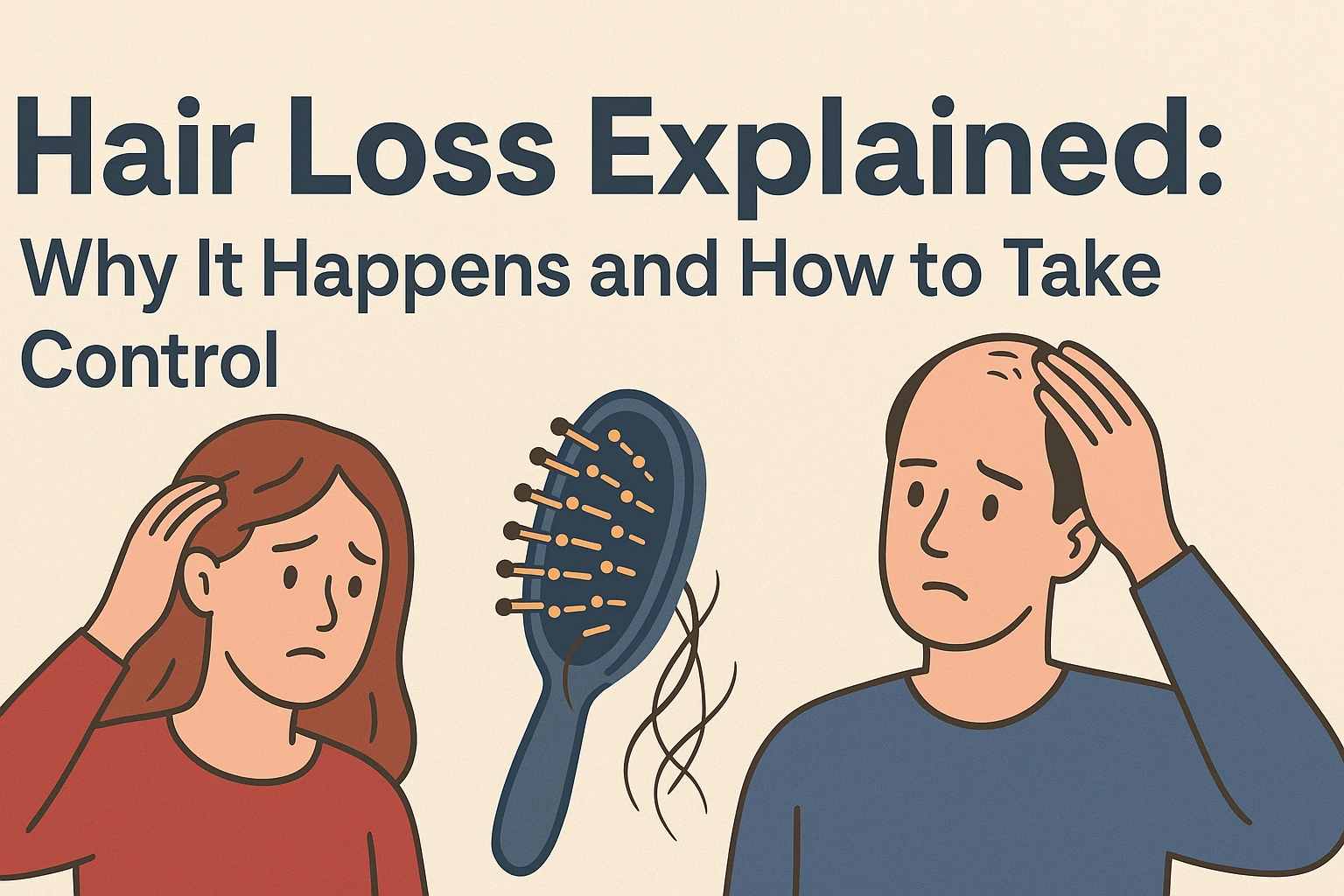Hair and Confidence: More Than Just Looks
Hair isn’t just a style statement — it’s a symbol of self-expression and confidence. Whether you’re in a boardroom, on camera, or meeting people daily, healthy hair often boosts how you feel about yourself.
In world, hair loss has become increasingly common, especially among young adults. What starts as a small receding hairline or widening part can soon affect confidence, focus, and even social interactions. But hair loss isn’t merely a cosmetic concern — it’s often tied to health, hormones, and lifestyle factors.
What Hair Loss Really Means
Clinically, most types of reduced scalp density are grouped under the term alopecia. The most common form is pattern hair loss (androgenetic alopecia) —
-
In men: it typically begins with a receding hairline and thinning on the crown.
-
In women: it shows as a gradual reduction in hair volume across the top of the scalp.
Other causes include:
-
Autoimmune conditions like alopecia areata that cause patchy bald spots.
-
Telogen effluvium, where hair shedding increases after illness, surgery, or extreme stress.
-
Traction alopecia, caused by tight hairstyles, excessive heat, or chemical treatments.
It’s normal to lose about 50–100 strands daily. Concern arises when you notice reduced density or visible scalp exposure.
Why It Matters in Professional Life
Hair loss can subtly affect performance and self-image at work:
-
Confidence and Presence: People may avoid presentations, photos, or video calls.
-
Focus and Energy: Constant worry about appearance can reduce concentration.
- Talent Retention: Organizations that support employee well-being — including access to dermatologists or coverage for treatments — promote loyalty and trust.
Top Causes of Hair Loss
1. Genetics
Family history plays a major role. If your parents or grandparents experienced pattern baldness, you might inherit the tendency.
2. Hormonal Changes
Thyroid imbalance, menopause, postpartum changes, or androgen sensitivity can disrupt the hair growth cycle. Women with PCOS or irregular cycles are particularly at risk.
3. Stress
Chronic or sudden stress can push follicles into a resting phase, leading to delayed shedding a few months later. Major surgery, illness, or infection can trigger this as well.
4. Styling Damage
Frequent use of heat tools, harsh dyes, tight braids, or chemical treatments weakens follicles, leading to breakage and eventual hair loss.
Start with Diagnosis — Not Products
The biggest mistake people make? Trying every trending serum or oil without knowing the root cause.
The smarter first step is to see a dermatologist or trichologist (hair and scalp specialist).
They’ll examine your scalp, take a detailed history, and may run lab tests to identify deficiencies or hormonal imbalances. Proper diagnosis saves time, money, and unnecessary damage.
Treatment Options — Simplified
Topical Treatments
-
Minoxidil: The most widely recommended solution for both men and women. Requires consistent use for several months.
Oral Medications
- Finasteride (for men) helps block the hormone responsible for hair loss.
-
Spironolactone or hormonal therapy (for women) may be prescribed under medical supervision.
Advanced Therapies
-
PRP (Platelet-Rich Plasma) injections stimulate hair regrowth using your own blood platelets.
-
Low-Level Laser Therapy (LLLT) can improve hair density and scalp health.
Surgical Options
Supportive Measures
Low-Level Laser Therapy (LLLT) can improve hair density and scalp health.Hair Transplant (FUE/FUT): Involves moving healthy follicles to thinning areas. Best for stabilized hair loss.
-
-
Iron, Vitamin D, Biotin, and Zinc supplementation.
-
Protein-rich diet and hydration.
-
Limiting heat styling and harsh treatments.
-
Stress management practices like yoga, walking, or mindfulness.
-
Patience Pays: Understanding the Timeline
Hair regrowth doesn’t happen overnight. Most treatments require:
-
3–6 months for initial improvement
-
9–12 months for visible regrowth
Stopping treatment can lead to gradual reversal of progress. Take consistent photos in the same lighting every few months to monitor results.
Women’s Hair Loss: Early Detection Is Key
Women often experience diffuse thinning rather than bald patches, which can delay diagnosis.
If you also notice irregular periods, acne, or weight gain, these could signal hormonal issues like PCOS or thyroid imbalance. Early medical attention ensures better outcomes.
How Organizations Can Support Employees
Workplaces can play a vital role in normalizing hair loss conversations.
-
Promote Awareness: Include dermatology and wellness programs.
-
Flexible Appearance Standards: Allow medical accommodations during treatment phases.
-
Confidential Support: Offer counseling or access to trusted medical professionals.
Smart Buying & Tracking Tips
Before investing in any product:
-
Consult a specialist — not every solution fits everyone.
-
Take monthly progress photos for realistic comparison.
-
Beware of exaggerated marketing claims and “instant cure” promises.
-
Ask about side effects and maintenance plans before committing.
Four Steps to Take This Week
-
Book a dermatologist appointment if you’ve noticed thinning for over 3 months.
-
Do lab tests to check for deficiencies or hormonal imbalances.
-
Start gentle scalp care: less heat, mild shampoo, and stress-reducing habits.
-
Set reminders to track progress every 6 months.
Conclusion: Regain Control, Not Just Hair
Hair loss is deeply personal but also highly manageable. With the right diagnosis, consistent treatment, and patience, most people can regain both hair density and confidence.
The true goal isn’t perfect hair — it’s restoring your sense of self and ensuring that your attention stays where it matters most: on living and working with confidence.
Read Also: Renia Bigham, Founder Of Conscious Empowerment Coaching, LLC
Discover more from The Success Prime
Subscribe to get the latest posts sent to your email.












Leave a Reply